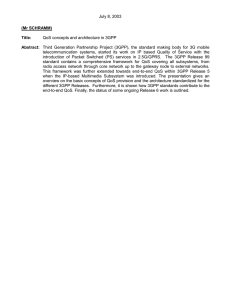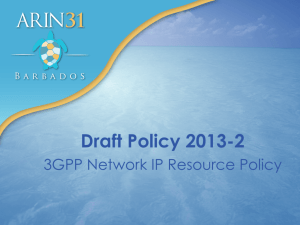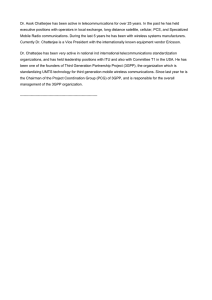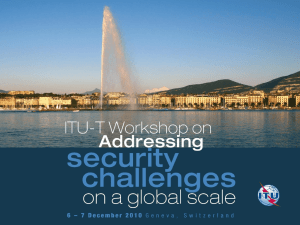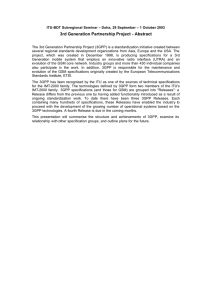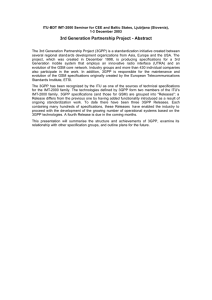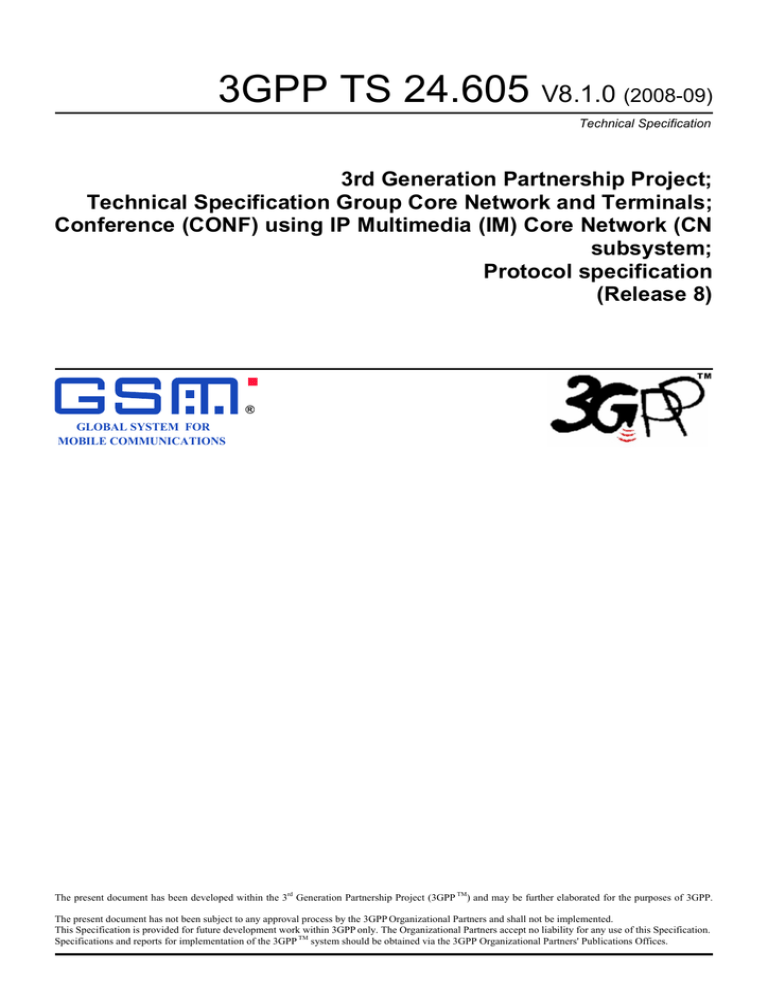
3GPP TS 24.605 V8.1.0 (2008-09)
Technical Specification
3rd Generation Partnership Project;
Technical Specification Group Core Network and Terminals;
Conference (CONF) using IP Multimedia (IM) Core Network (CN
subsystem;
Protocol specification
(Release 8)
R
GLOBAL SYSTEM FOR
MOBILE COMMUNICATIONS
The present document has been developed within the 3rd Generation Partnership Project (3GPP TM) and may be further elaborated for the purposes of 3GPP.
The present document has not been subject to any approval process by the 3GPP Organizational Partners and shall not be implemented.
This Specification is provided for future development work within 3GPP only. The Organizational Partners accept no liability for any use of this Specification.
Specifications and reports for implementation of the 3GPP TM system should be obtained via the 3GPP Organizational Partners' Publications Offices.
Release 8
2
3GPP TS 24.605 V8.1.0 (2008-09)
Keywords
CONF, supplementary service
3GPP
Postal address
3GPP support office address
650 Route des Lucioles - Sophia Antipolis
Valbonne - FRANCE
Tel.: +33 4 92 94 42 00 Fax: +33 4 93 65 47 16
Internet
http://www.3gpp.org
Copyright Notification
No part may be reproduced except as authorized by written permission.
The copyright and the foregoing restriction extend to reproduction in all media.
© 2008, 3GPP Organizational Partners (ARIB, ATIS, CCSA, ETSI, TTA, TTC).
All rights reserved.
3GPP
Release 8
3
3GPP TS 24.605 V8.1.0 (2008-09)
Contents
Foreword ............................................................................................................................................................5
1
Scope ........................................................................................................................................................6
2
References ................................................................................................................................................6
3
Definitions and abbreviations...................................................................................................................7
3.1
3.2
4
Definitions ......................................................................................................................................................... 7
Abbreviations..................................................................................................................................................... 7
CONFerence (CONF) ..............................................................................................................................7
4.1
Introduction........................................................................................................................................................ 7
4.2
Description......................................................................................................................................................... 7
4.2.1
General description ...................................................................................................................................... 7
4.3
Operational requirements................................................................................................................................... 8
4.3.1
Provision/withdrawal ................................................................................................................................... 8
4.3.2
Requirements on the originating network side ............................................................................................. 8
4.3.3
Requirements in the network........................................................................................................................ 8
4.3.4
Requirements on the terminating network side ............................................................................................ 8
4.4
Coding requirements.......................................................................................................................................... 8
4.5
Signalling requirements ..................................................................................................................................... 8
4.5.1
Activation/deactivation ................................................................................................................................ 8
4.5.1a
Registration/erasure...................................................................................................................................... 8
4.5.1b
Interrogation................................................................................................................................................. 8
4.5.2
Invocation and operation.............................................................................................................................. 8
4.5.2.1
Actions at the originating UE ................................................................................................................. 8
4.5.2.1.1
User joining a conference ................................................................................................................. 8
4.5.2.1.2
User inviting another user to a conference........................................................................................ 8
4.5.2.1.3
User leaving a conference ................................................................................................................. 9
4.5.2.1.4
User creating a conference................................................................................................................ 9
4.5.2.1.5
Subscription for the conference event package................................................................................. 9
4.5.2.2
Actions at the conferencing AS .............................................................................................................. 9
4.5.2.2.1
Conference focus .............................................................................................................................. 9
4.5.2.2.1A
AS Procedures with 3PCC ................................................................................................................ 9
4.5.2.2.2
Conference notification service ...................................................................................................... 10
4.5.2.3
Void ...................................................................................................................................................... 10
4.5.2.4
Void ...................................................................................................................................................... 10
4.5.2.5
Void ...................................................................................................................................................... 10
4.5.2.6
Void ...................................................................................................................................................... 10
4.5.2.7
Actions at the destination UE ............................................................................................................... 10
4.5.2.8
Void ...................................................................................................................................................... 10
4.5.2.9
Void ...................................................................................................................................................... 10
4.6
Interaction with other services ......................................................................................................................... 10
4.6.1
Communication HOLD (HOLD) ............................................................................................................... 10
4.6.2
Terminating Identification Presentation (TIP) ........................................................................................... 11
4.6.3
Terminating Identification Restriction (TIR) ............................................................................................. 11
4.6.4
Originating Identification Presentation (OIP) ............................................................................................ 11
4.6.5
Originating Identification Restriction (OIR) .............................................................................................. 11
4.6.6
CONFerence calling (CONF)..................................................................................................................... 11
4.6.7
Communication DIVersion services (CDIV) ............................................................................................. 11
4.6.8
Malicious Communication IDentification (MCID).................................................................................... 11
4.6.9
Anonymous Communication Rejection and Communication Barring (ACR/CB)..................................... 11
4.6.10
Explicit Communication Transfer (ECT)................................................................................................... 11
4.7
Interworking with other networks.................................................................................................................... 12
4.7.1
Void............................................................................................................................................................ 12
4.7.2
Void............................................................................................................................................................ 12
4.7.3
Void............................................................................................................................................................ 12
4.8
Parameter values (timers) ................................................................................................................................ 12
3GPP
Release 8
4
Annex A (informative):
3GPP TS 24.605 V8.1.0 (2008-09)
Signalling flows ..............................................................................................13
A.1
CONF interworking signalling flow in case of an active communication between IMS and PSTN .....13
A.2
Call flow for 3PTY CONF .....................................................................................................................19
A.2.1
A.2.2
A.3
Invite other user to 3PTY CONF by sending REFER request ......................................................................... 19
Invite other user to 3PTY CONF by sending INVITE request with URI list .................................................. 21
CONF call with REFER interworking at the AS ...................................................................................23
Annex B (informative):
Change history ...............................................................................................26
3GPP
Release 8
5
3GPP TS 24.605 V8.1.0 (2008-09)
Foreword
This Technical Specification has been produced by the 3rd Generation Partnership Project (3GPP).
The contents of the present document are subject to continuing work within the TSG and may change following formal
TSG approval. Should the TSG modify the contents of the present document, it will be re-released by the TSG with an
identifying change of release date and an increase in version number as follows:
Version x.y.z
where:
x the first digit:
1 presented to TSG for information;
2 presented to TSG for approval;
3 or greater indicates TSG approved document under change control.
y the second digit is incremented for all changes of substance, i.e. technical enhancements, corrections, updates,
etc.
z the third digit is incremented when editorial only changes have been incorporated in the document.
3GPP
Release 8
1
6
3GPP TS 24.605 V8.1.0 (2008-09)
Scope
The present document specifies the stage three Protocol Description of the Conference (CONF) service based on stage
one and two of the ISDN CONF supplementary service. It provides the protocol details in the IP Multimedia (IM) Core
Network (CN) subsystem based on the Session Initiation Protocol (SIP) and the Session Description Protocol (SDP).
The present document specifies centralized conferencing, using a conference focus, distributed conferencing is out of
scope.
The present document does not cover the cases of :
a) cascading conference services; and
b) the support of the PSTN/ISDN conference service hosted in the PSTN.
The present document is applicable to User Equipment (UE) and Application Servers (AS) which are intended to
support the CONF supplementary service.
2
References
The following documents contain provisions which, through reference in this text, constitute provisions of the present
document.
• References are either specific (identified by date of publication, edition number, version number, etc.) or
non-specific.
• For a specific reference, subsequent revisions do not apply.
• For a non-specific reference, the latest version applies. In the case of a reference to a 3GPP document (including
a GSM document), a non-specific reference implicitly refers to the latest version of that document in the same
Release as the present document.
[1]
3GPP TS 22.173: "IP Multimedia Core Network Subsystem (IMS) Multimedia Telephony Service
and supplementary services; Stage 1".
[2]
3GPP TS 24.229: "Internet Protocol (IP) multimedia call control protocol based on Session
Initiation Protocol (SIP) and Session Description Protocol (SDP); Stage 3".
[3]
Void
[4]
Void.
[5]
Void.
[6]
Void.
[7]
3GPP TS 24.147: "Conferencing using the IP Multimedia (IM) Core Network (CN) subsystem;
Stage 3".
[8]
IETF RFC 3891: "The SIP Replaces header".
[9]
Void.
[10]
Void
[11]
3GPP TS 24.628: "Common Basic Communication procedures using IP Multimedia (IM) Core
Network (CN) subsystem; Protocol specification".
[12]
3GPP TS 24.610: "Communication HOLD (HOLD) using IP Multimedia (IM) Core Network
(CN) subsystem; Protocol specification".
3GPP
Release 8
7
3
Definitions and abbreviations
3.1
Definitions
3GPP TS 24.605 V8.1.0 (2008-09)
For the purposes of the present document, the terms and definitions given in 3GPP TS 22.173 [1] and 3GPP TS 24.147
[7] apply.
3.2
Abbreviations
For the purposes of the present document, the following abbreviations apply:
ACR/CB
AS
CDIV
CONF
CS
ECT
HOLD
IMS
IP
ISDN
MCID
MGCF
OIP
OIR
P-CSCF
PSTN
SIP
TIP
TIR
UE
Anonymous Communication Rejection and Communication Barring
Application Server
Communication DIVersion
CONFerence calling
Circuit Switch
Explicit Communication Transfer
communication HOLD
IP Multimedia Subsystem
Internet Protocol
Integrated Service Data Network
Malicious Communication IDentification
Media Gateway Control Function
Originating Identification Presentation
Originating Identification Restriction
Proxy CSCF
Public Switched Telephone Network
Session Initiation Protocol
Terminating Identification Presentation
Terminating Identification Restriction
User Equipment
4
CONFerence (CONF)
4.1
Introduction
The CONFerence (CONF) service enables a user to participate in and control a simultaneous communication involving
a number of users.
4.2
Description
4.2.1
General description
When the CONF service is invoked, conference resources are allocated to the served user.
Once a conference is active, users can join and leave a conference, and remote users can be added to or removed from
the conference.
Conference participants can request to be informed of these actions.
3GPP
Release 8
8
4.3
Operational requirements
4.3.1
Provision/withdrawal
3GPP TS 24.605 V8.1.0 (2008-09)
The CONF service shall be provided after prior arrangement with the service provider.
4.3.2
Requirements on the originating network side
No specific requirements are needed in the network.
4.3.3
Requirements in the network
No specific requirements are needed in the network.
4.3.4
Requirements on the terminating network side
No specific requirements are needed in the network.
4.4
Coding requirements
For coding requirements see 3GPP TS 24.147 [7], clause 5.
4.5
Signalling requirements
4.5.1
Activation/deactivation
The CONF service is activated at provisioning and deactivated at withdrawal.
4.5.1a
Registration/erasure
The CONF service requires no registration. Erasure is not applicable.
4.5.1b
Interrogation
Interrogation of CONF is not applicable.
4.5.2
Invocation and operation
This subclause describes the usage of and the changes to the procedures of 3GPP TS 24.147 [7] for invoking and
operating a conference.
4.5.2.1
Actions at the originating UE
4.5.2.1.1
User joining a conference
Procedures according to 3GPP TS 24.147 [7], subclause 5.3.1.4 shall apply.
4.5.2.1.2
User inviting another user to a conference
Procedures according to 3GPP TS 24.147 [7], subclause 5.3.1.5 shall apply with the following additions to subclause
5.3.1.5.3 of 3GPP TS 24.147 [7]:
•
In order to avoid the establishment of a second communication to the invited user, in case of an active session
the UE may additionally include the Replaces header in the header portion of the SIP URI of the Refer-to
3GPP
Release 8
9
3GPP TS 24.605 V8.1.0 (2008-09)
header of the REFER request. The included Replaces header shall refer to the active dialog that is replaced by
the ad-hoc conference. The Replaces header shall comply with RFC 3891 [8].
NOTE 1: In case of an interworking to the PSTN the routing of the INVITE request from the conference focus to
the MGCF that handles the Replaces information is not deterministic and the replacement of the active
dialog might fail.
EXAMPLE:
Refer-To: <sip:mgcf1.home1.net; method=INVITE?Replaces=cb03a0s09a2sdfglkj490333%3Btotag%3D 314159%3Bfrom-tag%3D171828&Requrie=replaces >.
NOTE 2: If a conference participant invites another user to a conference by using a REFER request targeted at the
other user (following 3GPP TS 24.147 [7] , subclause 5.3.1.5.2), there can be cases where such REFER
request is intercepted by an AS serving the requesting user which applies special REFER handling
procedures according to 3GPP TS 24.628 [11] subclause 4.7.2.9.7.2. The consequence of this is that the
conference focus AS will receive an INVITE from the referrers AS and not from the targeted user. This
however does not affect the conference focus procedures in any way.
4.5.2.1.3
User leaving a conference
Procedures according to 3GPP TS 24.147 [7], subclause 5.3.1.6 shall apply.
4.5.2.1.4
User creating a conference
Procedures according to 3GPP TS 24.147 [7], subclause 5.3.1.3 shall apply.
4.5.2.1.5
Subscription for the conference event package
Procedures according to 3GPP TS 24.147 [7], subclause 5.3.1.2 shall apply.
4.5.2.2
4.5.2.2.1
Actions at the conferencing AS
Conference focus
Procedures according to 3GPP TS 24.147 [7] , subclauses 5.3.2 and 6.3.2 shall apply with the following additions to
subclause 5.3.2.5.2 of 3GPP TS 24.147 [7]:
-
If a Referred-By header is available in the REFER request, the AS shall verify if the provided Referred-By
header contains a valid identity of the requesting user. If not, the AS shall replace the Referred-By header with a
valid value matching the P-Asserted-Identity header in the REFER request.
If no Referred-By header is available in the request, the AS shall add a Referred-By header that matches the P-AssertedIdentity header in the REFER request.
The procedures described in subclause 5.3.2.5.5 of 3GPP TS 24.147 [7] shall not apply.
4.5.2.2.1A
AS Procedures with 3PCC
If 3-Way Calling with 3PCC is applied, the AS serving the controlling UE shall first check that a valid REFER request
is received on the dialog to be transferred:
-
The Request-URI in the REFER request is targeted to the same UE instance (remote UE) that is involved in the
dialog; and,
-
The Refer-To header in the REFER request contains an URI so that the method constructed from the URI is
equal to an INVITE request to the Conference focus.
Otherwise, the AS may, depending on the operator policy:
-
Reject the REFER request; or,
-
Handle the REFER request with another service; or
-
Proxy the REFER request on.
3GPP
Release 8
10
3GPP TS 24.605 V8.1.0 (2008-09)
If the AS determines that the REFER request is valid for 3PCC, the AS shall:
-
terminate the REFER request from the controlling UE by sending 202 Accepted response;
-
send a NOTIFY request containing the message/sipfrag body of "SIP/2.0 100 Trying";
-
send an INVITE request to the conference server without SDP content body based on the Refer-To header in the
REFER request;
Upon receiving a reliable response (reliable 18x response or 200 OK response) from the conference server, due to the
AS generated INVITE request triggered by a REFER request, the AS shall generate a re-INVITE request to the remote
UE identified in that REFER request. The re-INVITE shall include the media information in the SDP offer that matches
what was received from the conference server. The re-INVITE request is sent to the remote UE over the existing dialog.
Upon receiving a reliable response (200 OK) to the re-INVITE request from the remote UE with SDP answer
information in the message body, the AS shall include the media information in the SDP answer into the next eligible
request toward the conference server as an answer to the original SDP offer received. The next eligible request may be
one of the following:
-
PRACK request for a reliable 18x response; or
-
ACK request for 200 (OK) response.
Upon successful completion of the 3PCC procedure between the conference server and the remote UE, the AS shall
send a NOTIFY request to the controlling UE to indicate that the call transfer has been completed based on the REFER
request.
4.5.2.2.2
Conference notification service
In case of the subscription of a conference participant to the conference notification service, procedures according to
3GPP TS 24.147 [7], subclause 5.3.3 shall apply.
4.5.2.3
Void
4.5.2.4
Void
4.5.2.5
Void
4.5.2.6
Void
4.5.2.7
Actions at the destination UE
Upon receipt of an INVITE request that includes a Replaces header, the UE shall apply the procedures described in
RFC 3891 [8] to the INVITE request.
4.5.2.8
Void
4.5.2.9
Void
4.6
Interaction with other services
4.6.1
Communication HOLD (HOLD)
The AS supporting the CONF service shall support the procedures for the held UE as specified in
3GPP TS 24.610 [12]
3GPP
Release 8
4.6.2
11
3GPP TS 24.605 V8.1.0 (2008-09)
Terminating Identification Presentation (TIP)
No impact, i.e. neither service shall affect the operation of the other service.
4.6.3
Terminating Identification Restriction (TIR)
For the conferencing AS implementing the conference focus, the following applies:
-
If a participant is added to the conference and if TIR is active for the terminating party of this session, then the
identity information of that participant shall not be included in conference notifications to other participants.
4.6.4
Originating Identification Presentation (OIP)
No impact, i.e. neither service shall affect the operation of the other service.
4.6.5
Originating Identification Restriction (OIR)
For the conferencing AS implementing the conference focus, the following applies:
-
If a participant joins the conference and if OIR is active for the originating party of this session, then the identity
information of that participant shall not be included in conference notifications to other participants.
-
If a REFER request is received and if the Privacy header field is set to "header" or "user", then for the INVITE
request to the refer-to target, the conference AS shall:
a) not insert the Referred-by header field, if it does not exist in the REFER request; or
b) remove the Referred-By header field, if the Privacy header field of the REFER request is set to "user".
-
If an INVITE request with "recipient-list" body is received, and if the Privacy header field is set to "user", then
the conference AS shall anonymize the From header field of resulting reINVITE request, if there is established
dialog between the conference controller and the target of the reINVITE request.
4.6.6
CONFerence calling (CONF)
Not applicable.
NOTE:
4.6.7
Cascading conference services are out of scope of the present specification.
Communication DIVersion services (CDIV)
No impact, i.e. neither service shall affect the operation of the other service.
4.6.8
Malicious Communication IDentification (MCID)
No impact, i.e. neither service shall affect the operation of the other service.
4.6.9
Anonymous Communication Rejection and Communication Barring
(ACR/CB)
The focus AS shall not accept REFER requests with a refer-to target that is barred by the conference creators
Outgoing Communication Barring (OCB) rules.
The focus AS shall remove the URI that is barred by the conference creator Outgoing Communication Barring (OCB)
rules from the list of URIs in the "recipient-list" body of INVITE request.
4.6.10
Explicit Communication Transfer (ECT)
No impact, i.e. neither service shall affect the operation of the other service.
3GPP
Release 8
12
4.7
Interworking with other networks
4.7.1
Void
4.7.2
Void
4.7.3
Void
4.8
Parameter values (timers)
Not applicable.
3GPP
3GPP TS 24.605 V8.1.0 (2008-09)
Release 8
13
3GPP TS 24.605 V8.1.0 (2008-09)
Annex A (informative):
Signalling flows
A.1
CONF interworking signalling flow in case of an
active communication between IMS and PSTN
Figure A.1 depictures a flow where two UEs are engaged in a call, and one of the users is located in the PSTN. At some
point in time, UE A decides to activate the CONF service and move the call to a centralized conference. UE A creates
the conference, and provides instructions to the conference server to contact UE B and replace the initial
communication with a communication to the conference server.
3GPP
Release 8
14
UE-A
P-CSCF
1. INVITE
S-CSCF
3GPP TS 24.605 V8.1.0 (2008-09)
AS/MRFC
MRFP
2. INVITE
PSTN/
ISDN
MGCF
MGW
3. INVITE
4. Interaction to
reserve resources
5. IAM
7. ANM
8.Interaction for
session establishment
11. 200 OK
12. ACK
9. 200 OK
10. 200 OK
13. ACK
14. ACK
Bearer
Channel
RTP
15. INVITE
16. INVITE
17. INVITE
18. Interaction for creating
an conference
21. 200 OK
22. ACK
20. 200 OK
23. ACK
19. 200 OK
24. ACK
RTP
25. REFER
26. REFER
27. REFER
27a. Interactions to reserve resources
for an additional participant in the
conference
30. NOTIFY
29. NOTIFY
28. NOTIFY
31. INVITE
32. INVITE
33. Interaction for switching
existing bearer channel to
new RTP session
34. 200 OK
35. 200 OK
35a. Interactions to add the
participant to the conference
36. ACK
37. ACK
RTP
40. NOTIFY
44. BYE
45. 200 OK
39. NOTIFY
38. NOTIFY
41. switching existing bearer
channel to new RTP session
42. BYE
43. BYE
46. 200 OK
47. 200 OK
no RTP sent
Figure A.1: CONF interworking signalling flow in case of an active communication
between IMS and PSTN
-
Description figure A.1
NOTE:
Only the most relevant messages are shown in figure A.1
UE-A is in an active voice session with a PSTN/ISDN TE (SIP dialog with Call-ID, to-tag and from-tag between UE-A
and MGCF). It then creates a conference and invites the PSTN/ISDN TE to the conference by sending a REFER to the
conference focus, which invites the PSTN/ISDN TE to the conference by sending an INVITE which includes the
Replaces header to the MGCF. The MGCF confirms the session, switches the existing bearer channel to the new RTP
session, and terminates the session which is replaced.
1. to 3. UE-A initiates a voice session with a PSTN/ISDN TE by sending an INVITE request to the MGCF.
3GPP
Release 8
15
3GPP TS 24.605 V8.1.0 (2008-09)
Table A.1: 1.INVITE (UE-A to P-CSCF)
INVITE tel:+1-212-555-2222 SIP/2.0
Via: SIP/2.0/UDP [5555::aaa:bbb:ccc:ddd]:1357;comp=sigcomp;branch=z9hG4bKnashds7
Max-Forwards: 70
Route: <sip:pcscf1.visited1.net:7531;lr;comp=sigcomp>, <sip:scscf1.home1.net;lr>
P-Preferred-Identity: "John Doe" <sip:user1_public1@home1.net>
P-Access-Network-Info: 3GPP-UTRAN-TDD; utran-cell-id-3gpp=234151D0FCE11
Privacy: none
From: <sip:user1_public1@home1.net>;tag=171828
To: <tel:+1-212-555-2222>
Call-ID: cb03a0s09a2sdfglkj490333
Cseq: 127 INVITE
Require: sec-agree
Proxy-Require: sec-agree
Supported: precondition, 100rel
Security-Verify: ipsec-3gpp; q=0.1; alg=hmac-sha-1-96; spi-c=98765432; spi-s=87654321; port-c=8642;
port-s=7531
Contact: <sip:[5555::aaa:bbb:ccc:ddd]:1357;comp=sigcomp>
Allow: INVITE, ACK, CANCEL, BYE, PRACK, UPDATE, REFER, MESSAGE
Content-Type: application/sdp
Content-Length: (…)
v=0
o=- 2987933615 2987933615 IN IP6 5555::aaa:bbb:ccc:ddd
s=c=IN IP6 5555::aaa:bbb:ccc:ddd
t=0 0
m=video 3400 RTP/AVP 98 99
b=AS:75
a=curr:qos local none
a=curr:qos remote none
a=des:qos mandatory local sendrecv
a=des:qos none remote sendrecv
a=rtpmap:98 H263
a=fmtp:98 profile-level-id=0
a=rtpmap:99 MP4V-ES
m=audio 3456 RTP/AVP 97 96
b=AS:25.4
a=curr:qos local none
a=curr:qos remote none
a=des:qos mandatory local sendrecv
a=des:qos none remote sendrecv
a=rtpmap:97 AMR
a=fmtp:97 mode-set=0,2,5,7; maxframes=2
a=rtpmap:96 telephone-event
4: Interaction to reserve resources.
5: SS7: IAM.
7: SS7: ANM.
8: Interaction for session establishment.
9 to 11: The MGCF sends a final response back to the session originator.
Table A.2: 9. 200 OK (MGCF to S-CSCF)
SIP/2.0 200 OK
Via: SIP/2.0/UDP bgcf1.home1.net;branch=z9hG4bK6546q2.1, SIP/2.0/UDP
scscf1.home1.net;branch=z9hG4bK332b23.1, SIP/2.0/UDP pcscf1.home1.net;branch=z9hG4bK431h23.1,
SIP/2.0/UDP [5555::aaa:bbb:ccc:ddd]:1357;comp=sigcomp;branch=z9hG4bKnashds7
Record-Route: <sip:scscf1.home1.net;lr>, <sip:pcscf1.home1.net;lr>
P-Asserted-Identity: <tel:+1-212-555-2222>
P-Charging-Vector:
Privacy: none
From:
To: <tel:+1-212-555-2222>;tag=314159
Call-ID:
CSeq:
Require: 100rel
Contact: <sip:mgcf1.home1.net>
Allow: INVITE, ACK, CANCEL, BYE, PRACK, UPDATE
3GPP
Release 8
16
3GPP TS 24.605 V8.1.0 (2008-09)
RSeq: 9021
Content-Type: application/sdp
Content-Length: (…)
v=0
o=- 2987933623 2987933623 IN IP6 5555::eee:fff:aaa:bbb
s=c=IN IP6 5555::eee:fff:aaa:bbb
t=0 0
m=video 0 RTP/AVP 98 99
m=audio 6544 RTP/AVP 97 96
b=AS:25.4
a=curr:qos local none
a=curr:qos remote none
a=des:qos mandatory local sendrecv
a=des:qos none remote sendrecv
a=conf:qos remote sendrecv
a=rtpmap:97 AMR
a=fmtp:97 mode-set=0,2,5,7; maxframes=2
a=rtpmap:96 telephone-event
12 to 14: The Calling party acknowledges the final response with an ACK request.
15 to 24: UE-A creates a conference by sending an INVITE request to the Conference Factory URI and connects to the
conference.
Table A.3: 15. INVITE request (UE-A to P-CSCF)
INVITE sip:conference-factory1@mrfc1.home1.net SIP/2.0
Via: SIP/2.0/UDP [5555::aaa:bbb:ccc:ddd]:1357;comp=sigcomp;branch=z9hG4bKnashds7
Max-Forwards: 70
Route: <sip:pcscf1.visited1.net:7531;lr;comp=sigcomp>, <sip:orig@scscf1.home1.net;lr>
P-Preferred-Identity: "John Doe" <sip:user1_public1@home1.net>
P-Access-Network-Info: 3GPP-UTRAN-TDD; utran-cell-id-3gpp=234151D0FCE11
Privacy: none
From: <sip:user1_public1@home1.net>; tag=171829
To: <sip:conference-factory1@mrfc1.home1.net>
Call-ID: cb03a0s09a2sdfglkj490444
Cseq: 127 INVITE
Require: sec-agree
Proxy-Require: sec-agree
Supported: precondition, 100rel
Security-Verify: ipsec-3gpp; q=0.1; alg=hmac-sha-1-96; spi-c=98765432; spi-s=87654321; port-c=8642;
port-s=7531
Contact: <sip:[5555::aaa:bbb:ccc:ddd]:1357;comp=sigcomp>
Allow: INVITE, ACK, CANCEL, BYE, PRACK, UPDATE, REFER, MESSAGE, SUBSCRIBE, NOTIFY
Content-Type: application/sdp
Content-Length: (…)
v=0
o=- 2987933615 2987933615 IN IP6 5555::aaa:bbb:ccc:ddd
s=c=IN IP6 5555::aaa:bbb:ccc:ddd
t=0 0
m=video 3400 RTP/AVP 98 99
b=AS:75
a=curr:qos local none
a=curr:qos remote none
a=des:qos mandatory local sendrecv
a=des:qos none remote sendrecv
a=rtpmap:98 H263
a=fmtp:98 profile-level-id=0
a=rtpmap:99:MPVMP4V-ES
m=audio 3456 RTP/AVP 97 96
b=AS:25.4
a=curr:qos local none
a=curr:qos remote none
a=des:qos mandatory local sendrecv
a=des:qos none remote sendrecv
a=rtpmap:97 AMR
a=fmtp:97 mode-set=0,2,5,7; maxframes=2
a=rtpmap:96 telephone-event
3GPP
Release 8
17
3GPP TS 24.605 V8.1.0 (2008-09)
25 to 27: UE-A invites the PSTN/ISDN TE to the conference by sending a REFER request to the conference focus, the
"method" parameter set to "INVITE". The Refer-To header of the REFER request includes the Replaces parameter with
Call-ID, to-tag and from-tag from the existing SIP dialog.
Table A.4: 25. REFER request (UE-A to P-CSCF)
REFER sip: conference1@mrfc1.home1.net SIP/2.0
Via: SIP/2.0/UDP [5555::aaa:bbb:ccc:ddd]:1357;comp=sigcomp;branch=z9hG4bKnashds7
Max-Forwards: 70
Route: <sip:pcscf1.visited1.net:7531;lr;comp=sigcomp>, <sip:orig@scscf1.home1.net;lr>
P-Preferred-Identity: "John Doe" <sip:user1_public1@home1.net>
P-Access-Network-Info: 3GPP-UTRAN-TDD; utran-cell-id-3gpp=234151D0FCE11
Privacy: none
From: <sip:user1_public1@home1.net>; tag=171829
To: <sip:conference1@mrfc1.home1.net>
Call-ID: cb03a0s09a2sdfglkj490555
Cseq: 127 REFER
Require: sec-agree
Refer-To: <sip:mgcf1.home1.net; method=INVITE?Replaces=cb03a0s09a2sdfglkj490333%3Btotag%3D314159%3Bfrom-tag%3D171828&Requrie=replaces >
Referred-By: <sip:user1_public1@home1.net>
Proxy-Require: sec-agree
Security-Verify: ipsec-3gpp; q=0.1; alg=hmac-sha-1-96; spi-c=98765432; spi-s=87654321; port-c=8642;
port-s=7531
Contact: <sip:[5555::aaa:bbb:ccc:ddd]:1357;comp=sigcomp>
Content-Length: 0
27a: Interactions to reserve resources for an additional participant in the conference.
28 to 30: The conference focus sends a NOTIFY request containing information about the progress of the REFER
request processing. The Subscription-State is set to "active".
31 to 32: The conference focus invites the PSTN/ISDN TE by sending an INVITE request to the MGCF. The INVITE
request includes the Replaces header with Call-ID, to-tag and from-tag from the existing SIP dialog.
Table A.5: 31. INVITE request (MRFC/AS to S-CSCF)
INVITE sip:mgcf1.home1.net SIP/2.0
Via: SIP/2.0/UDP mrfc1.home1.net;branch=z9hG4bK23273846
Max-Forwards: 70
P-Asserted-Identity: <sip:conference1@mrfc1.home1.net>
P-Charging-Vector: icid-value="AyretyU0dm+6O2IrT5tAFrbHLso=023551024"; orig-ioi=home1.net
Privacy: none
From: <sip:conference1@mrfc1.home1.net>;tag=171123
To: <sip:mgcf1.home1.net>
Call-ID: bc03a0s09a2sdfglkj490333
Cseq: 127 INVITE
Require: replaces
Replaces: cb03a0s09a2sdfglkj490333;to-tag=314159;from-tag=171828
Supported: precondition, 100rel
Referred-By: <sip:user1_public1@home1.net>
Contact: <sip:conference1@mrfc1.home1.net>;isfocus
Allow: INVITE, ACK, CANCEL, BYE, PRACK, UPDATE, REFER, MESSAGE, SUBSCRIBE, NOTIFY
Allow-Events: conference
Content-Type: application/sdp
Content-Length: (…)
v=0
o=- 2987933615 2987933615 IN IP6 5555::abc:def:abc:abc
s=c=IN IP6 5555::abc:def:abc:def
t=0 0
m=video 10001 RTP/AVP 98
b=AS:75
a=curr:qos local none
a=curr:qos remote none
a=des:qos mandatory local sendrecv
a=des:qos none remote sendrecv
a=rtpmap:98 H263
a=fmtp:98 profile-level-id=0
m=audio 6544 RTP/AVP 97 96
b=AS:25.4
a=curr:qos local none
3GPP
Release 8
18
3GPP TS 24.605 V8.1.0 (2008-09)
a=curr:qos remote none
a=des:qos mandatory local sendrecv
a=des:qos none remote sendrecv
a=rtpmap:97 AMR
a=fmtp:97 mode-set=0,2,5,7; maxframes=2
a=rtpmap:96 telephone-event
33: Interaction for switching existing bearer channel to new RTP.
34 to 35: The MGCF sends a final response back to the session originator.
35a: Interaction to add the participant to the conference.
36 to 37: The Calling party acknowledges the final response with an ACK request.
38 to 40: The conference focus sends a NOTIFY request containing information about the progress of the REFER
request processing. The Subscription-State is set to "terminated".
41: The MGCF replaces the existing RTP stream to UE-A with the new RTP stream to the conferencefocus.
42 to 44: The MGCF releases the session with UE-A by sending a BYE request to UE-A.
45 to 47: UE-A responds with a 200 OK response.
3GPP
Release 8
19
3GPP TS 24.605 V8.1.0 (2008-09)
A.2
Call flow for 3PTY CONF
A.2.1
Invite other user to 3PTY CONF by sending REFER request
Figure A.2 depictures a flow where two UEs, UE-1 and UE-2, are engaged in a call. At some point in time, UE-1
decides to involve UE-3 into the communication and activate the 3PTY CONF service. UE-1 puts UE-2 on hold,
initiates a session toward UE-3 to get the user's permission to start 3PTY call, creates the conference, and moves the
original communication with both UE-2 and UE-3 to the conference server.
3GPP
Release 8
20
3GPP TS 24.605 V8.1.0 (2008-09)
Figure A.2: Call flow for 3PTY conference
UE-1 and UE-2 are in an active call. UE-1 decides to add UE-3 to make it a 3-way conferencing call.
3GPP
Release 8
21
3GPP TS 24.605 V8.1.0 (2008-09)
1. UE-1 and UE-2 are in an active call.
2. UE-1 puts UE-2 on hold before invoking the 3-Way Calling with UE-3.
3~11. UE-1 establishes a call with UE-3 following normal call setup procedure and gets UE-3’s permission to start the
3-Way Calling.
12~14. UE-1 sends an INVITE request to the conference server to establish a conference session.
15. The CS coordinates with MRFP to allocate conference resources.
16~21. The CS sends a 200 (OK) response and receives an ACK request from UE-1.
22~27. UE-1 sends a REFER request to UE-2 with the Refer-To header set to the address of the CS; UE-2 accepts the
REFER request.
28~33. UE-2 sends a NOTIFY request to UE-1 to indicate that UE-2 is acting on the REFER request.
34~35. UE-2 sends an INVITE request to the CS to join the conference.
36. The CS coordinates with MRFP to allocate more resources.
37~40. The CS sends a 200 (OK) response to UE-2 and receives an ACK request.
41~46. UE-2 sends a NOTIFY request to UE-1 to indicate that it has finished action required by the REFER request.
47~52. UE-1 sends a BYE request to terminate the call between itself and UE-2.
53~58. In parallel to step 22~52, UE-1 sends a REFER request to UE-3 with the Refer-To header set to the address of
the CS; UE-3 accepts the REFER request.
59~64. UE-3 sends a NOTIFY request to UE-1 to indicate that UE-3 is acting on the REFER request.
65~66. UE-3 sends an INVITE request to the CS to join the conference.
67. The CS coordinates with MRFP to allocate more resources.
68~71. The CS sends a 200 (OK) response to UE-3 and receives an ACK request.
72~77. UE-3 sends a NOTIFY request to UE-1 to indicate that it has finished action required by the REFER request.
78~83. UE-1 sends a BYE request to terminate the call between itself and UE-3.
A.2.2
Invite other user to 3PTY CONF by sending INVITE request
with URI list
Figure A.3 depictures a flow where UA-A is involved in 2 communications with UA-B and UA-C, both
2 communications are on-hold. The AS is involved in both 2 communications as a B2BUA.
When user A intends to start the 3PTY conference, UA-A sends an INVITE request to the AS to create the conference
and indicates that certain dialogs will be re-used for this conference, The AS sends re-INVITEs in the indicated dialogs
and connects the media to the conference bridge. The dialogs can be indicated by adding the Call-ID header field, the
From header field and the To header field to the entries in the URI list of the initial INVITE request.
3GPP
Release 8
22
3GPP TS 24.605 V8.1.0 (2008-09)
Figure A.3: Call flow for 3PTY conference
1: UA-A creates a conference and invites user B and user C to the conference by sending an INVITE request to the
Conference Factory URI and including URI list in the INVITE request, UA-A indicates the certain dialogs which be reused for this conference in the uri list by ? mechanism.
INVITE CONF AS
To: CONF AS
From: A
Require: recipient-list-invite
Content-Type: application/resource-lists+xml
Content-Disposition: recipient-list
<?xml version="1.0" encoding="UTF-8"?>
3GPP
Release 8
23
3GPP TS 24.605 V8.1.0 (2008-09)
<resource-lists xmlns="urn:ietf:params:xml:ns:resource-lists"
xmlns:cp="urn:ietf:params:xml:ns:copyControl">
<list>
<entry uri="B?Call-ID=1a&From=A%3Btag%3Da&To=B%3Btag%3Db" cp:copyControl="to"/>
<entry uri="C?Call-ID=2a&From=A%3Btag%3Da&To=C%3Btag%3Dc" cp:copyControl="to"/>
</list>
</resource-lists>
2: AS verifies if the dialogs in URI list matches to a partial dialog which AS already involved, In the case of a match the
AS use this dialog ID information to send re-INVITE request to UA-B and UA-C in the partial dialogs between the AS
and the invited users in order to connect the media of the invited users to the MRFP.
A.3
CONF call with REFER interworking at the AS
Figure A.4 depicts a flow where two UEs, UE-1 and UE-2, are engaged in a call. At some point in time, UE-1 decides
to involve UE-3 into the communication and activate the CONF service. In this scenario, third party call control at the
AS is employed to interwork the REFER request to an INVITE request. Such a scenario is applicable since some
endpoints do not support the REFER method.
3GPP
Release 8
24
3GPP TS 24.605 V8.1.0 (2008-09)
Figure A.4: CONF call with REFER interworking at the AS
UE-1 and UE-2 are in an active call. UE-1 decides to add UE-3 to make it a 3-way conferencing call.
1: UE-1 and UE-2 are in an active call. The AS is put on the signalling path of this call by invoking the iFC. The
dialog ID between the AS and UE-2 is D1.
2: UE-1 puts UE-2 on hold before invoking the 3-Way Calling with UE-3.
3: UE-1 establishes a call with UE-3 following normal call setup procedure and gets UE-3’s permission to start the
3-Way Calling. The AS is put on the signalling path of this call by invoking the iFC.
3GPP
Release 8
25
3GPP TS 24.605 V8.1.0 (2008-09)
4: UE-1 decides to covert the two on-going calls into a 3-way call and puts UE-3 on hold.
5 to 8: UE-1 sends an INVITE request to the CS to establish a conference session. The AS is put on the signalling
path of this call be invoking the iFC. The dialog ID between the AS and the CS is D3.
9: The CS coordinates with MRFP to allocate conference resources.
10 to 17: The CS sends a 200 (OK) response and receives an ACK request from UE-1.
18 to 23: UE-1 sends a REFER request to UE-2 with the Refer-To header set to the address of the CS. The AS
sends a 202 (Accepted) response and terminates the REFER request in order to perform REFER interworking.
24 to 29: The AS sends a NOTIFY request to UE-1 to indicate that the AS is processing the REFER request.
30: The AS sends an empty INVITE request to the CS (dialog D4) to join the conference created by UE-1.
31: The CS coordinates with MRFP to allocate more resources.
32: The CS sends a 200 (OK) response to the AS. This response includes an SDP offer (O1) based on the conference
information.
33 to 34: The AS sends a re-INVITE request with SDP offer (O1) to UE-2 on the existing dialog (D1) to update the
session to conference session.
35 to 36: UE-2 sends a 200 (OK) response to the AS to acknowledge the re-INVITE request. This response
contains an SDP answer (A1) based on the SDP offer (O1) received.
37: The AS sends an ACK request with SDP answer (A1) to the CS to reply to the SDP offer received in Step 32.
End-to-End offer/answer exchange between the CS and UE-2 is completed.
38 to 39: The AS also sends an ACK request to UE-2 to acknowledge the 200 (OK) response from UE-2.
40 to 45: The AS sends a NOTIFY request to UE-1 to indicate that it has finished action required by the REFER
request.
46 to 51: UE-1 sends a BYE request to terminate the dialog used for communication between itself and UE-2.
52: In parallel to step 18 through 51, UE-1 follows the similar procedures to add UE-3 into the conference.
3GPP
Release 8
26
3GPP TS 24.605 V8.1.0 (2008-09)
Annex B (informative):
Change history
Change history
Date
2008-01
2008-01
2008-01
TSG #
TSG Doc.
CR
2008-02
2008-04
2008-05
2008-05
2008-06
CT#40
CP-080326
2008-09
CT#41
2008-09
CT#41
2008-09
CT#41
CP-080533 000
1
CP-080533 000
2
CP-080533 000
3
Rev Subject/Comment
Publication as ETSI TS 183 005
Conversion to 3GPP TS 24.505
Technically identical copy as 3GPP TS 24.605 as basis for further
development.
Implemented C1-080097, C1-080424, C1-080426
Old
New
2.5.0
2.5.1
2.5.1
2.6.0
Implemented C1-080878, C1-081082, C1-081083, C1-081245.
Implemented C1-081550, C1-081906, C1-081909.
Editorial changes done by MCC
CP-080326 was approved by CT#40 and version 8.0.0 is created
by MCC for publishing
Correction of reference
2.8.0
2.8.1
2.7.0
2.8.0
2.8.1
8.0.0
8.0.0
8.1.0
Applicability statement in scope
8.0.0
8.1.0
Interaction of HOLD and CONF
8.0.0
8.1.0
3GPP

